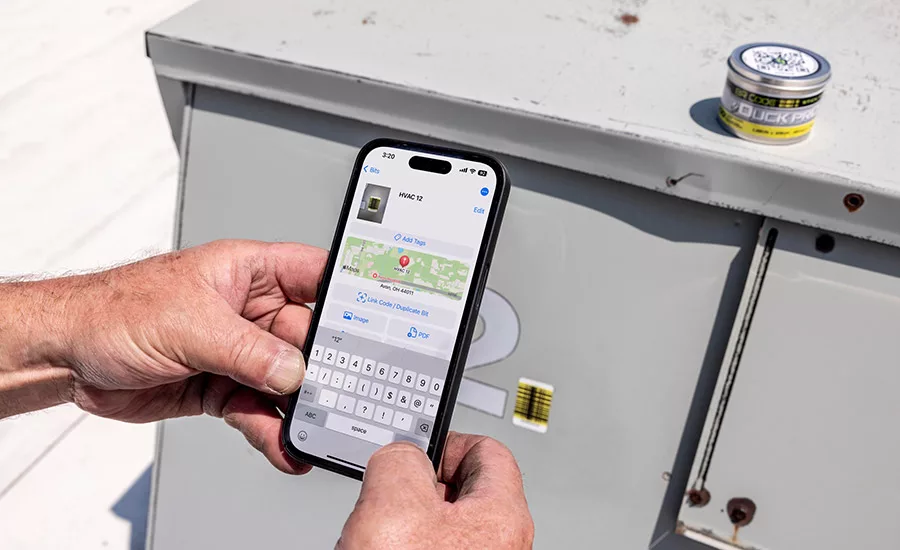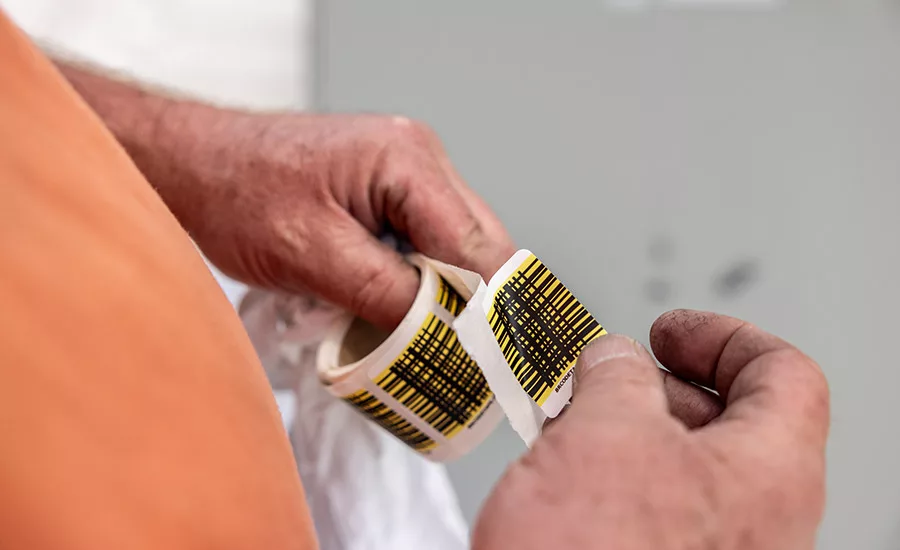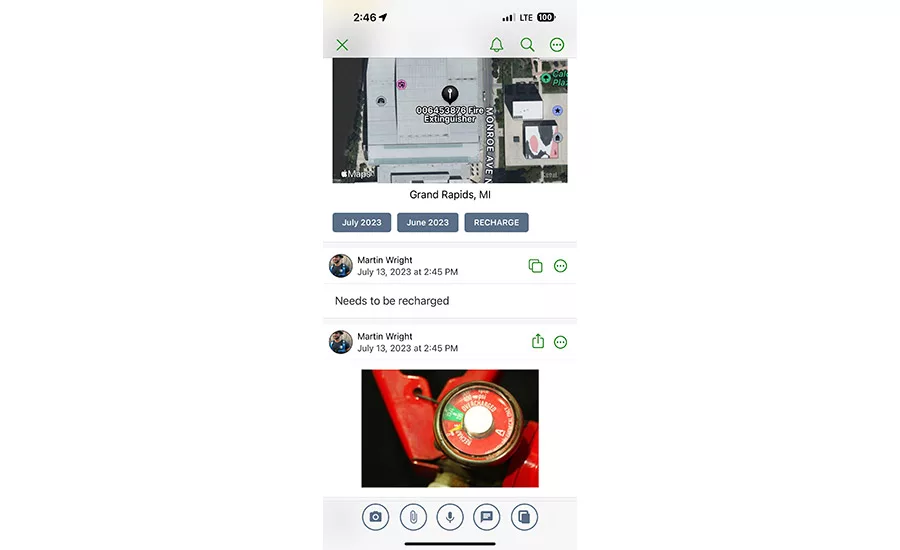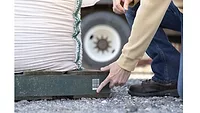Scannable Tapes and Labels Use App to Connect Objects to Locations and Digital Information
Combining traditional tools like adhesive tapes and labels with modern app technology, two companies partnered to create a solution that is solving real and timely issues in a number of industries.


Duck Pro® by Shurtape® BR Code™ Scannable Solutions

Coded Tapes and Labels

Using the App
A new line of scannable tapes and labels allows users to stick unique codes to everything from materials and equipment to backhoes, then add GPS locations and other digital information to the codes using a free, easy-to-use mobile app.
Each code and its linked files are stored in the cloud and available to anyone with the app and access permission, making tracking and organizing easier and more accurate for project managers.
Small Cost, Big Impact
Called Duck Pro® by Shurtape® BR Code™ Scannable Solutions, the new tapes and labels and their corresponding BitRip® app were created through a joint partnership between adhesive tape manufacturer Shurtape Technologies, LLC, and tech startup Nastro Technologies. The preprinted tapes and labels are rugged to withstand demanding, high-traffic environments like construction sites, home repair service calls, and order processing centers, and can be stuck to a variety of surfaces. The code printed on each tape is designed to work with the BitRip mobile app, which is free and available for download on a smartphone or tablet from the Apple App Store for iOS and Google Play for Android.
Users can stick a piece of tape or a label to a tool, product, or piece of equipment — anything that needs to be tracked — and scan it using the BitRip app. Once the code is scanned, users can upload photos, videos, voice memos, PDFs, and project notes to associate with the code. The app automatically generates a timestamp and updates the object’s GPS location each time the code is scanned.
The information connected to a code can be shared with others who have the app, and they can add to it or modify it as needed based on their individual permissions. Access to any code can be customized to control who can view and modify the content.
Together, the coded tapes, labels, and the app have been making an impact across a variety of industries and applications. The speed with which this cloud-based solution is being implemented is due in large part to how easy it is to use and how little investment is required to get started. The only hard cost is purchasing the coded tape or labels. The app is intuitive, but users can also find support in a variety of short how-to videos.
How It’s Being Used
This scannable tape solution is being implemented by a variety of businesses for organizing, tracking, and locating. Here are some examples of how they’re using it:
- Material tracking: Losing material deliveries on large jobsites can lead to high expenses in replacement costs, disrupted work schedules, and reputation damage. Sticking and scanning coded tape or a label on materials and equipment before shipping, taking a photo of the shipment and scanning again when it arrives on site provides instant confirmation of receipt and the precise timing and location of the delivery.
- Safety data: Maintaining safety records is a daunting task, and accessing records during an OSHA inspection can take hours. Instantly digitizing records using a coded piece of tape and a mobile device puts critical documents at the user’s fingertips in seconds, whether in the office or out in the field.
- Equipment inspections: Site supervisors and safety coordinators can stick a code on a piece of equipment and use the app to record and track inspection information and add other helpful resources like the operator’s manual, serial number, and required training for operation.
- Maintenance and repair records: In addition to supplying convenient access to equipment serial numbers and operator manuals, technicians can use the code and app to add their own individual notes. Notes can include details about where they are in the maintenance or repair process and specific details about repair history, component replacements, and part numbers. This makes it easy for the next technician to pick up and continue without duplicating effort.
- Punch lists: Tagging items requiring maintenance or repair work with a code and adding a voice memo that explains what needs to be done simplifies communication. Workers can then scan the code, listen to the instructions, and get to work. The app even offers one-touch Spanish translation.
- Tool and equipment training: Placing a code on a tool or piece of equipment and linking it to an instructional video or “how to use” checklist allows anyone with the app to easily access instructions.
Armed with this effortless way to capture, organize and access records, instructions, trainings, delivery tracking, and more, businesses are continually discovering new ways to use the coded tape and app to operate more efficiently.
Coded Tapes and Labels
To make this new product widely usable in a variety of environments, the coded tapes and labels are offered in multiple formats. For rugged indoor and outdoor environments, the duct tape version includes a waterproof polyethylene film with a cloth carrier backing and a natural rubber adhesive, and it has a perforated liner for clean, easy tearing. The 10-mil thick material offers conformability for wrapping around objects, without losing usability, making the codes easy to adhere to a variety of surfaces and substrates.
For indoor applications and temporary use, the 5.8 mil paper tape codes are constructed with a flatback paper backing and rubber-based adhesive.
For long-term adhesion, codes can be purchased as permanent scannable labels. Permanent labels are constructed with a polypropylene backing, acrylic-based adhesive and polyester liner, with a service temperature range of 0 °F to 200 °F. The heavy duty version of the permanent scannable label conforms to BS 5609 and has a service temperature range from -40 °F to 200 °F.
Using the App
To set up a tape or label code, the user opens the app on their mobile device, takes a photo of the code and touches the “Create label” button. Then, the label can be named and the user can begin uploading or adding the information they wish to be connected to the label, such as documents, images, and media. To organize and share the information with others, the app also includes a number of additional functions, such as:
- Grouping codes together for a project;
- Assigning access permission to individuals or a group;
- Adding and deleting members to projects or groups;
- Receiving a notification each time a code is scanned;
- Setting reminders;
- Editing, adding to, or updating digital information linked to a code;
- Accessing the most recent timestamp and GPS location; and
- Recording audio notes.
The app allows for unlimited data and an unlimited number of users, and it is completely free with no subscription necessary. By design, it can be implemented throughout an organization and across departments without additional licensing fees or other costs commonly associated with scaling digital tools.
Case Study #1: Safety Recordkeeping in Construction
Every construction site has a safety coordinator who is responsible for ensuring all workers are following company safety policies and performing to OSHA standards. For a large commercial construction company, that can mean tracking multiple pieces of large equipment and hundreds of personnel as well as all of the documentation needed to satisfy OSHA requirements. Those documents must also be produced on-demand during onsite inspections and for other operational needs like ensuring personnel are properly trained to operate equipment.
One safety practice that can be challenging to organize is site-specific safety inspection orientation. When a new worker is assigned to a jobsite, they must complete training about the site’s safety rules before they can start working. Some construction companies add a sticker to workers' hardhats to provide a quick visual confirmation of training completion. But the sticker is typically not linked to the person who completed the training. This can present a liability issue if the sticker comes off and a safety-related incident occurs.
To solve this problem, Clancy & Theys Construction Co., a large commercial contractor in North Carolina, decided to test the coded tape and mobile app on a jobsite where approximately 80 workers and half a dozen pieces of equipment were active daily. After each worker completed the site-specific safety training, Safety Coordinator Jared Fornes stuck a piece of the coded tape to the worker’s hardhat, captured the code, and linked it to the worker’s name.* He also added more information, such as other training they had completed, safety certifications they held, and equipment they were authorized to operate. The information then became instantly accessible to others on the team who had the app.
Later, Fornes realized the app could also be used as liability protection. For instance, if a site foreman observed a subcontractor operating a piece of equipment they weren’t trained on, the foreman could add a note to that worker’s code and a photo of the equipment. This created an instant record of the event with a timestamp and GPS location.
Case Study #2: Shipment Tracking for an Electrical Engineer
For Faith Technologies, an Alabama-based company in the electrical engineering, design, and installation field, shipment tracking and error-free product delivery were top of mind when they tried the coded tape and app. Here, Electrical Project Manager Aaron Hunsucker is responsible for the prefab warehouse, preparing large lighting assemblies for shipping and making sure shipments arrive intact on the jobsite.
Equipped with a roll of scannable tape and the mobile app, Hunsucker and his team started sticking a piece of tape to each lighting assembly shipment before it left the warehouse. The team then scanned each code to create a timestamp and capture the assembly’s geolocation. They also added a shipping ticket and a photo of the shipment to show the condition of the shipment before it left the warehouse.
Now, the company is able to keep a digital log of its lighting assemblies from one location to another, which is much more efficient than its previous method of entering information manually on an email-shared spreadsheet. The new method eliminates manual entry errors and avoids costly losses of shipments in transit and liability for damaged shipments. Moreover, the tape and app have given the company a project tool that they can use to group codes together and share information so that everyone stays apprised of shipment activity.
Tape and Tech Partnership Provides Needed Solution
By combining traditional tools like adhesive tapes and labels with modern app technology, two companies were able to partner to create a marketable solution that is solving real and timely issues in a multitude of industries. With low-cost productivity solutions that are easy to implement and learn, partnerships like this not only improve efficiency and productivity but also help alleviate some of the burden created by a tight labor market — and that’s a win-win for everyone.
For more information about BR Code™ Scannable Solutions, visit www.shurtape.com/brcode.
*Check hardhat manufacturer's recommendations for acceptable use of stickers before using BR Code in this manner.
Article images provided by Shurtape.
Looking for a reprint of this article?
From high-res PDFs to custom plaques, order your copy today!





